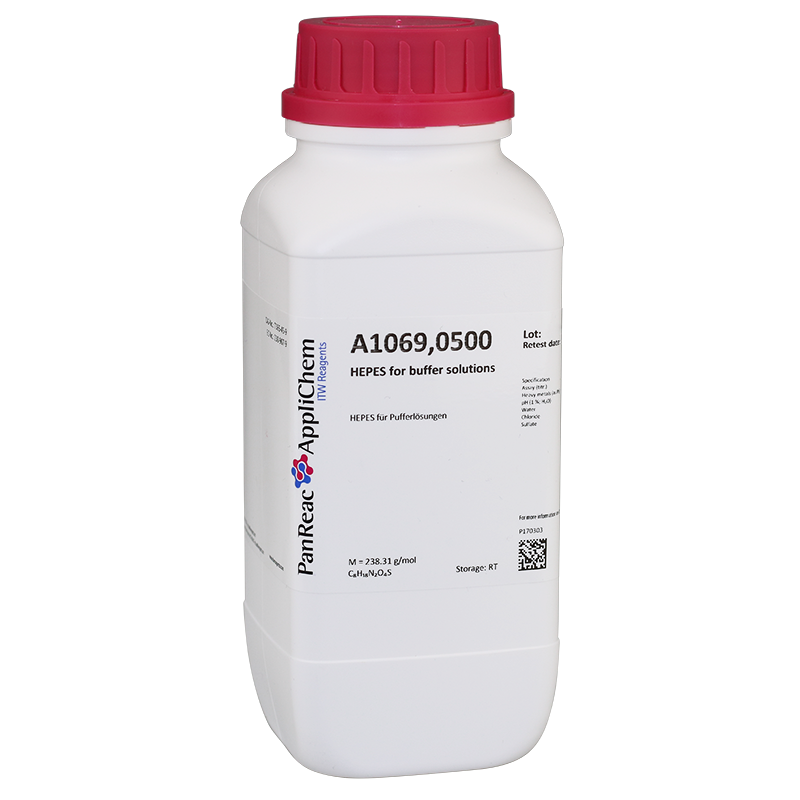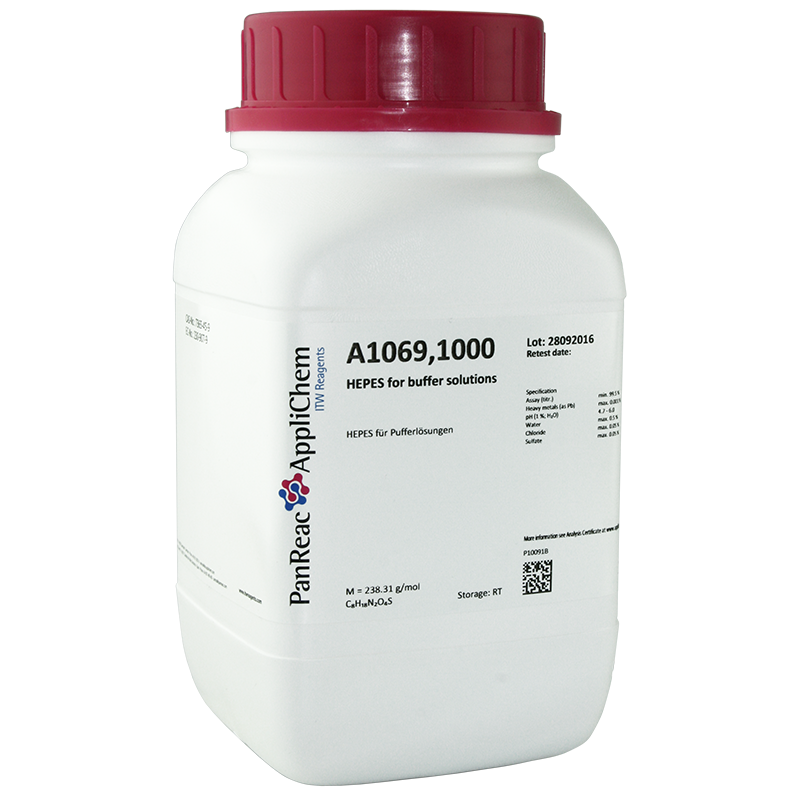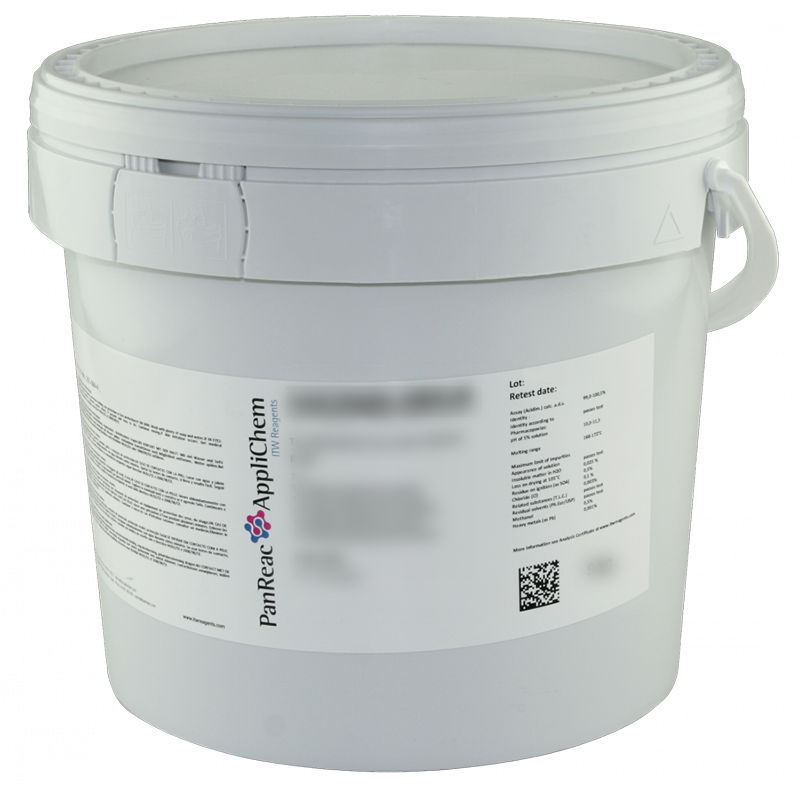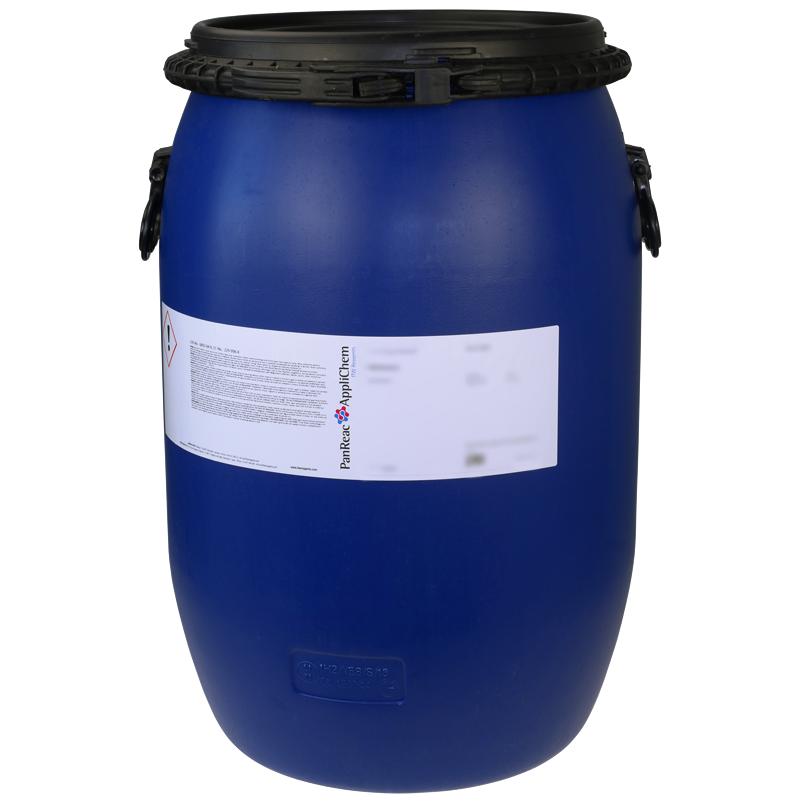Packs sizes (5)
| code | packaging size | price per unit | box price per unit | |
|---|---|---|---|---|
| Code & packaging | Price per piece | |||

|
code
A1069,0100
|
packaging size
100 g
|
price per unit
single
54,10€
|
box price per unit
|

|
code
A1069,0500
|
packaging size
500 g
|
price per unit
single
186,60€
|
box price per unit
|

|
code
A1069,1000
|
packaging size
1 kg
|
price per unit
single
307,60€
|
box price per unit
261,46€x 6 units
|

|
code
A1069,5000
|
packaging size
5 kg
|
price per unit
single
1332,70€
|
box price per unit
|

|
code
A1069,9025BW
|
packaging size
25 kg
|
price per unit
single
Request a quote
|
box price per unit
|
Technical data
- Physical Description:
- Solid
- Product Code:
- A1069
- Product Name:
- HEPES for buffer solutions
- Specifications:
- Assay (titr.): min. 99.5 %
pH (1 %; H2O): 4.7 - 6.0
Heavy metals (as Pb): max. 0.001 %
Water: max. 0.5 %
Chloride: max. 0.05 %
Sulfate: max. 0.05 %
- WGK:
- 1
- Storage:
- RT
- EINECS:
- 230-907-9
- CS:
- 29335995
Documents
Inquiry
Comments
About HEPES - HEPES is a short name for 2-(4-(2-hydroxyethyl)-1-piperazinyl)-ethanesulfonic acid, a buffer substance. - Chemical properties - HEPES is used for biochemical, molecular biological and microbiological purposes as a buffer substance from the group of good buffers. With an acid constant of pKs = 7.55 (at 20 °C), it has a good buffering capacity between pH 6.8 and 8.2. The temperature dependence is ΔpKs/ΔT = -0.014 K-1.HEPES is a widely used buffer in biological studies. There is only one restriction in the use of this buffer, because it interferes with the Folin protein assay. In cell culture media, it is employed as a substitute for the bicarbonate buffer at a concentration of 25 mM or as a supplement to the bicarbonate buffer (concentration 10 - 15 mM).The addition of 20 mM HEPES to TBE buffer improves the migration behaviour of certain samples in the SSCP analysis (single-strand conformation polymorphism), with a higher resolution especially if small differences in the sequences between certain bands are wanted (5).
"HEPES (or 4-(2-hydroxyethyl)-1-piperazineethane sulfonic acid) is a zwitterionic organic compound commonly used as a buffer solution in biochemistry. It belongs to the Good buffers. Since Good's work in 1966, it has been widely preferred to bicarbonate buffer for cell culture because of its better stability at physiological pH values.
HEPES is among the buffers with the best properties for biological studies (1,3,4). In cell culture, HEPES is used as a replacement for the bicarbonate buffer (then often at a concentration of 25 mM) or as an additional buffer to the bicarbonate (then often at a concentration of 10 - 15 mM). HEPES-buffered media are used especially when the stability of the pH value in the medium plays an important role. pH-value-sensitive cell culture systems receive additional buffering in the range of pH 7.2 - 7.6 through the addition of HEPES. Fluctuations in the pH value occur naturally through the metabolism of the cultured cells, but also with changes in the CO₂ concentration in the incubator or the surrounding environment (2). HEPES experiences limitations in usability in that it cannot be used when protein determination is to be performed after Folin. In addition, the piperazine ring system forms radicals under certain conditions. This buffer is therefore not suitable for the study of redox processes in biochemistry (5).The addition of 20 mM HEPES to the TBE buffer, improves the migration behavior of certain samples in SSCP (single-strand conformation polymorphism) analysis, where the resolution of particularly small sequence differences between individual bands is important (6)."









